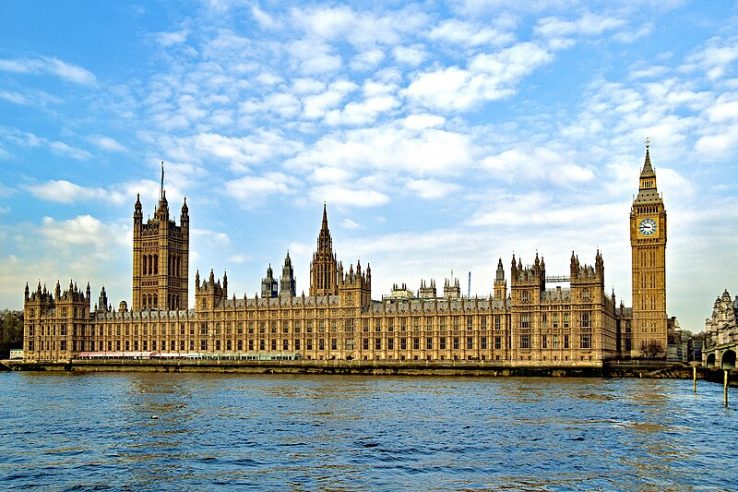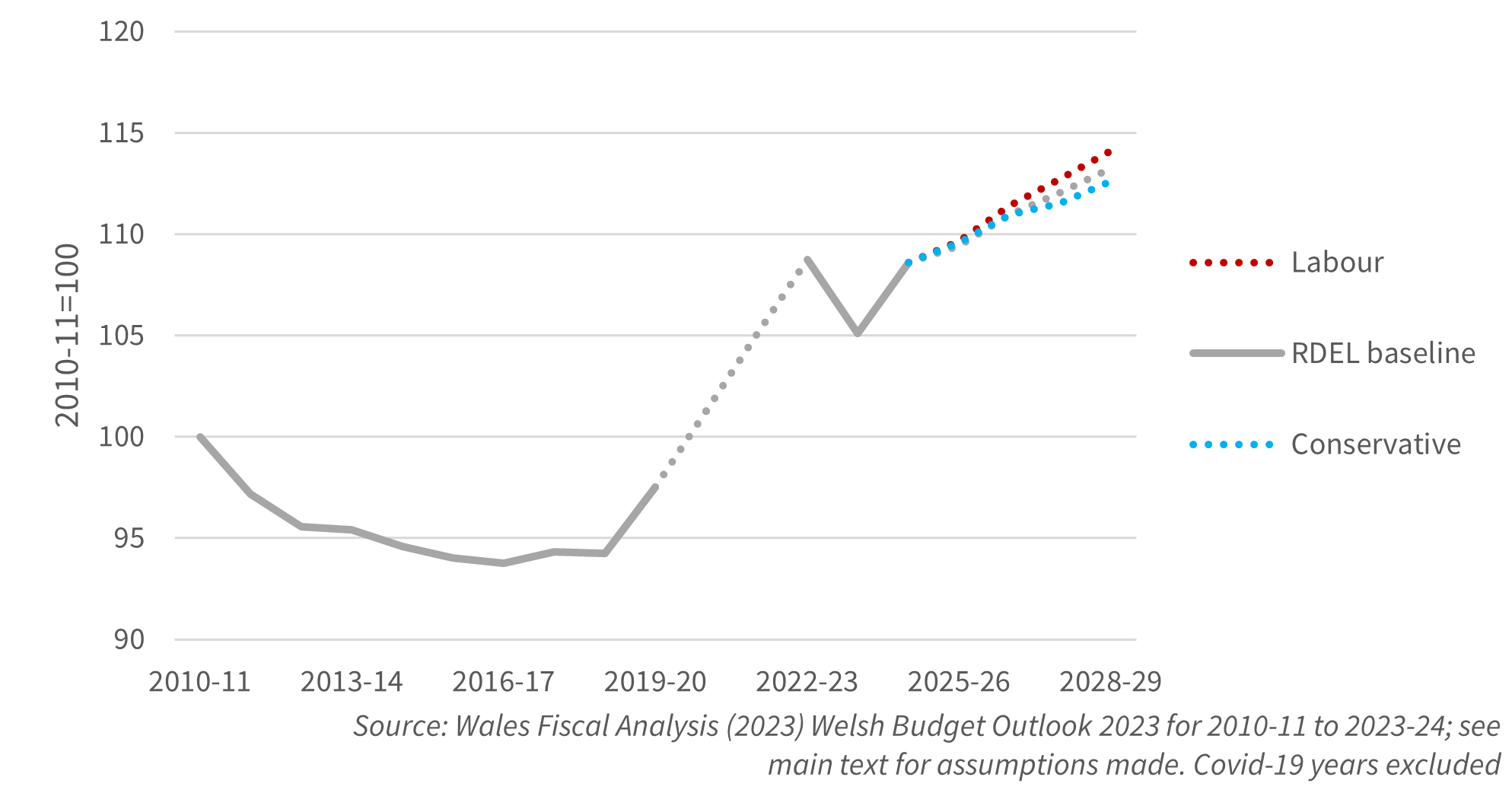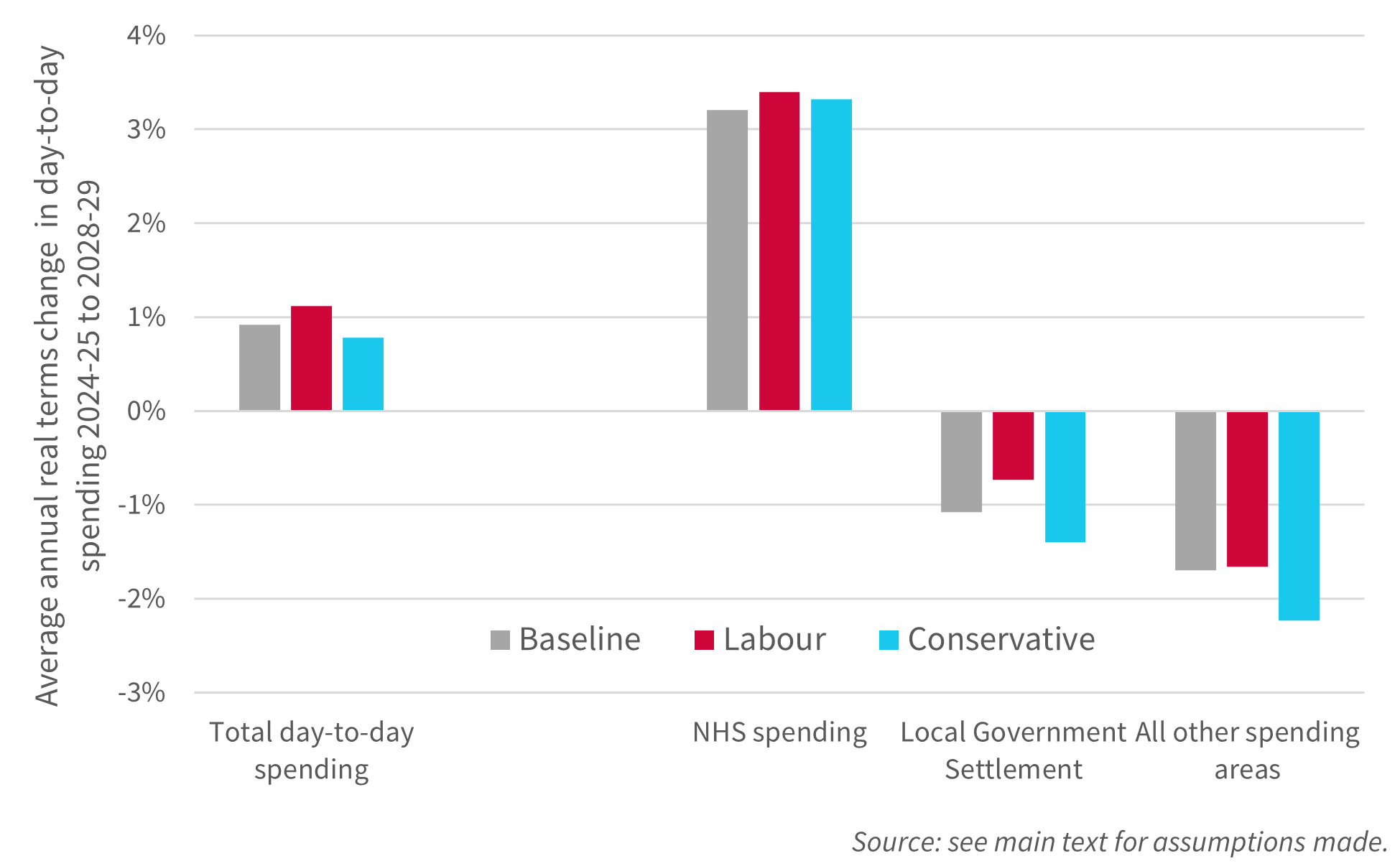Stark choices await the Welsh Budget – whichever party wins the UK General Election
26 June 2024
Wales Fiscal Analysis briefing on the implications of the 2024 General Election manifestos for the Welsh Government budget
As the General Election campaign reaches its final stages, the major UK parties have been accused – by the Institute for Fiscal Studies, no less – of a ‘conspiracy of silence’ around the difficult tax and spending trade-offs they’ll face if they win on the 4th of July.
At the Welsh level, even less light has been shed on how the parties’ tax and spending plans will impact Wales. As election debate moderators now increasingly stress, many of the commitments made during the campaign on health and education spending are for England only. And while we know that the parties’ headline pledges in these areas should trigger additional funding for the Welsh Government through the Barnett formula, an important consideration for the devolved budget will be the overall funding picture, including spending in policy areas that will be cut in real terms or left unprotected in England.
In this brief report, Wales Fiscal Analysis explores the implications for the Welsh Government budget from the tax and spending pledges made in the Conservative and Labour manifestos. Following the manifesto analysis of the Institute for Fiscal Studies and the National Institute of Economic and Social Research, we focus on the budgetary implications to Wales that stem from the manifestos of the two largest parties at the last General Election.
Serious budget challenges lie ahead:
- Both the Conservative and Labour manifestos largely maintain the trajectory of existing UK government spending plans. If these plans are implemented as intended by the manifestos, the Welsh Government would face serious budgetary challenges. It would have to implement further deep cuts to non-protected spending areas to fund increases to health spending.
- Under Conservative plans, the Welsh Government budget for day-to-day spending would increase by an average of 0.8% per year in real terms from 2024-25 to 2028-29. Assuming the Welsh Government directly ‘passes on’ consequentials from NHS and schools spending in England, a further £870 million of funding would be required by 2028-29 to avoid real-terms cuts to non-protected areas of spending.
- Under Labour’s plans, the Welsh Government budget for day-to-day spending would increase by an average of 1.1% per year in real terms from 2024-25 to 2028-29. Again assuming the Welsh Government directly passes on health and education consequentials, an additional £248 million of funding would be required in 2025-26 to avoid real terms cuts to non-protected spending areas, a gap which would grow to £683 million by 2028-29. It is unclear therefore how these plans would fulfil the promise of ‘no return to austerity’ under Labour. The additional consequential spending for Wales projected from the 2024 Labour manifesto amounts to just 5% of the consequential spending included in Labour’s 2019 manifesto.
- Welsh Government capital spending – which funds multi-year infrastructure projects such as school building, roads and hospital building – will also be cut in real terms under both parties’ manifesto plans. Under existing plans, the block grant for capital spending is set to fall by 7.7% in real terms from 2024-25 to 2028-29. The Labour manifesto contains additional investment spending under the Green Prosperity Plan, worth some £60 million per year for the Welsh Government. This would still however see the Welsh Government’s capital budget falling by 5% in real terms from 2024-25 to 2028-29.
- Crucially, both parties’ plans are highly dependent on a swift return to economic growth. Neither the Conservatives nor Labour intend to loosen the current Chancellor’s fiscal rules, and both parties have also ruled out increases to the main revenue-raising taxes. These pledges will seriously limit the next government’s ability to pump additional resources into public services. Moreover, the outlook for the public finances is underpinned by Office for Budget Responsibility forecasts for the economy (and for the resulting tax receipts), and these forecasts are significantly more optimistic than those of the Bank of England and the IMF.
The baseline scenario
Our baseline projections for the Welsh Government are based on the indicative UK government spending plans announced at the 2024 the Spring Budget. Since detailed departmental spending plans and implied consequentials beyond 2024-25 were not provided, we need to make a series of assumptions on how UK government likely intended to allocate spending to different departments.[1]
Under these assumptions, and using the latest devolved tax and Block Grant Adjustment forecasts, we project that the Welsh Government budget for day-to-day spending would grow by an average of 0.9% per year in real terms (i.e., after accounting for inflation), between 2024-25 and 2028-29.
If the Welsh Government decided to directly ‘pass on’ consequentials that would be triggered for the Welsh budget from additional health and education spending in England, this would mean:
- The NHS budget growing by 3.2% per year in real terms (which would be below likely spending pressures);
- The Local Government resource settlement falling by an average of 1.1% per year in real terms;[2]
- All other spending areas falling by an average of 1.7% per year in real terms.[3]
Under this baseline scenario, the Welsh Government would face immediate budgetary challenges, having to implement steep cuts to particular areas of spending in order to fund increased health spending.
This would continue a long-standing trend of non-protected funding being cut back. When the Welsh Government published its Draft Budget for 2024-25, it found cuts of £422 million in its spending plans outside the NHS and Transport for Wales. This pattern now means that spending outside the health service this year is about 10% lower in real terms than what it was in 2010.
We estimate that matching NHS spending pledges for England would require an additional £249 million of funding in 2025-26 to avoid real terms cuts in non-protected spending areas of the Welsh budget next year. This gap would increase to £687 million by 2028-29.
Conservative manifesto plans
The Conservative manifesto has left existing plans for spending on public services largely unchanged, topping up spending by just £500 million by the end of the decade. New spending commitments are made for defence and the NHS, funded largely through cuts to the Civil Service, cutting spending on consultants, and making unspecified ‘quango efficiencies’.
The precise implications for the Welsh Government of these commitments are unknowable, as no detail is provided on where or how these cuts will be made.
Assuming that ‘back office’ spending cuts are implemented across all departments equally, we project that growth in the Welsh Government budget will be slightly lower than the levels implied by our baseline plans, averaging 0.8% per year.
If the Welsh Government again decided to directly ‘pass on’ the implied increases to NHS England spending in the Conservative manifesto to the health budget in Wales, this would result in steeper cuts in non-protected spending elsewhere in the budget, averaging 2.2% per year in real terms.
In total, under Conservative plans, the Welsh Government would need some £870 million of additional funding to avoid real terms cuts to non-protected spending areas by 2028-29.
Labour manifesto plans
The Labour manifesto promises a top-up to existing spending plans of close to £5 billion by 2028-29, and these are focused primarily on health and education spending. These commitments would trigger approximately £195 million of additional consequential spending for the Welsh budget by 2028-29.[4]
But in the context of the projected £23 billion Welsh budget for day-to-day spending, this additional spending would not significantly alter the planned trajectory for the total Welsh budgetary ‘envelope’. Compared with the 0.9% per year real terms increases provided in the baseline assumptions outlined above, under the Labour manifesto the Welsh Government budget for day-to-day spending would increase by 1.1% per year on average in real terms, just 0.2 percentage points higher than current Conservative government spending plans.
Figure 1: Welsh Government budget for day-to-day spending (real terms, 2010-11=100)

Despite the slight increase in funding compared with the baseline scenario, the Welsh Government would still find future budget rounds very difficult. Because of the clear-cut nature of the health and education pledges in the Labour manifesto, we again assume that the (Labour) Welsh Government would directly ‘pass on’ any additional consequentials from above-baseline NHS and schools spending in England.
As shown in Figure 2, because the two major party manifestos focus their relatively small spending commitments on the health service, this would imply that Welsh NHS spending would increase by 3.4% per year in real terms to 2028-29. The Local Government settlement (with additional funding allocated for schools spending) would fall by 0.7% per year in real terms. The budget outlook is so tight in this scenario that all other spending areas would need to be cut by 1.7% per year in real terms.
Figure 2: Average annual real-terms change in projected Welsh Government spending (2024-25 to 2028-29)

An additional £248 million of funding would be required in 2025-26 to avoid these real terms cuts to all non-protected spending areas, which include rail, bus and road transport; business support; communities and regeneration; arts, culture and sport; and housing and homelessness. This gap would increase to £683 million by 2028-29. The implied scale of these budget cuts to services outside the Welsh NHS does not align with Rachel Reeves’ pledge that there ‘will not be return to austerity’ under an incoming Labour government.
In both budgetary and policy terms, the Labour 2024 manifesto stands in stark contrast to its 2019 forerunner. Labour’s promised additional consequentials for day-to-day spending in 2024 amount to just 5% of the forecasted consequentials from 2019 (without any adjustment for inflation). The pledges in the 2024 manifesto are similar in magnitude to the forecasted consequentials from the 2019 Conservative manifesto.
Capital spending
It is not only in day-to-day spending that the Welsh Government budget faces a difficult outlook. Indicative spending plans for departmental capital budgets were frozen in cash terms over the next five years – implying significant real terms cuts.
There are no additional consequentials for investment spending in the Conservative manifesto plans. The Welsh Government capital block grant would therefore be set to fall by 7.7% in real terms from 2024-25 to 2028-29 (on top of a steep fall this year).
The Labour manifesto contains additional investment spending under the Green Prosperity Plan. We estimate additional consequentials from this spending at £60 million per year for the Welsh Government. But the scale of this investment is dwarfed by the already pencilled-in real terms cuts to capital spending in the current government’s spending plans. In addition to our assumptions of additional NHS capital spending, even after Green Prosperity Plan spending the Welsh Government’s capital budget would fall by approximately 5% in real terms between 2024-25 and 2028-29.
Growth to the rescue?
Recall that neither the Conservatives nor Labour have pledged to loosen the fiscal rules imposed by the current Chancellor, and that both parties have ruled out increases to the main revenue-raising taxes such as income tax, national insurance contributions and VAT. This means that any scope for changing these post-election spending forecasts therefore largely depend on the outlook for economic growth, which influences tax receipts and affects many areas of public spending such as universal credit.
The Labour party argues that the scope for public spending increases will be improved by stronger economic growth. But the public finances outlook that underpins all these projections are the economic forecasts of the Office for Budget Responsibility. As has been noted elsewhere, the OBR’s forecasts are already significantly more optimistic than most other forecasters, including the Bank of England and the IMF.
Changing the spending outlook without changing taxes or borrowing will therefore require a sharp break from the UK’s dismal growth trajectory since the financial crisis of 2008.
Conclusion
In the final furlong of the 2024 campaign, the Director of the Institute for Fiscal Studies took the unusual step of directly criticising the major parties for avoiding the difficult questions on tax and spending that will face the UK after the General Election. This “conspiracy of silence” obscures the reality of a sluggish economy and serious budgetary challenges that will face the next government.
In this brief report, we have explored how the modest campaign pledges for health and education in the Labour and Conservative manifestos would impact the Welsh budget via the Barnett formula. Because of the almost singular focus on NHS spending pledges by the two major parties, the budgetary envelope for public services overall remains broadly in line with the extremely tight spending plans of the incumbent Conservative government.
Both parties’ decision to broadly maintain current spending trajectories presents significant challenges for the Welsh Government. The Conservative plan would increase the Welsh budget by just 0.8% annually in real terms, and if NHS England consequentials are directly passed on to the Welsh NHS this would necessitate an additional £870 million by 2028-29 to avoid cuts to non-protected areas of the budget. Labour’s plan proposes a slightly higher increase of 1.1% per year, but this remains just 0.2 percentage points higher than the current government’s spending plans. If implemented, an extra £248 million in 2025-26 and £683 million by 2028-29 would be needed to prevent real-term cuts to areas such as rail, bus and road transport; business support; communities and regeneration; arts, culture and sport; and housing and homelessness.
Finally, both parties’ plans imply real-term cuts in capital spending, further straining the Welsh Government’s ability to spend on new schools, hospitals, and transport infrastructure. Because both parties have ruled out increases to all the major taxes and have pledged to adhere to strict fiscal rules, the feasibility of these plans hinges on a rapid return to economic growth: an area in which the UK has continuously struggled since the financial crisis of 2008. Even with a change of governing party at Westminster, upcoming Welsh budget rounds therefore promise to be no less difficult than they have been in recent years.
[1] Namely: the NHS England budget increases by 3.6% per year; core schools funding in England is held constant in real terms; defence and foreign aid spending is grown in line with GDP; announced increases in Childcare spending go ahead; other, ‘non-protected’ spending is grown uniformly across departments.
[2] In nominal terms, the Local Government resource settlement would grow by an average of 0.6% per year (-0.8% in 2025-26, 1.3% in 2026-27, 0.9% in 2027-28, and 1.1% in 2028-29)
[3] If the Welsh Government also decided to allocate consequentials from the Childcare announcements in England on to a similar offer in Wales, then the cuts across other spending areas would be larger, at 2.4%.
[4] We assume most of this spending would be resource (day-to-day) spending, with the exception of a £250 million commitment to ‘double the number of NHS CT and MRI scanners’, which we assume would be mainly capital spending. We also assume that spending commitments on the NHS and education in England are additional to our assumed baseline spending scenario.
- December 2025
- November 2025
- October 2025
- September 2025
- June 2025
- May 2025
- March 2025
- February 2025
- December 2024
- October 2024
- September 2024
- July 2024
- June 2024
- December 2023
- November 2023
- August 2023
- February 2023
- December 2022
- November 2022
- September 2022
- July 2022
- April 2022
- March 2022
- January 2022
- October 2021
- July 2021
- May 2021
- March 2021
- January 2021
- November 2020
- October 2020
- August 2020
- July 2020
- June 2020
- May 2020
- April 2020
- March 2020
- October 2019
- September 2019
- June 2019
- April 2019
- March 2019
- February 2019
- December 2018
- October 2018
- July 2018
- June 2018
- April 2018
- December 2017
- October 2017
- July 2017
- June 2017
- May 2017
- April 2017
- March 2017
- February 2017
- January 2017
- December 2016
- November 2016
- October 2016
- September 2016
- Bevan and Wales
- Big Data
- Brexit
- British Politics
- Constitution
- Covid-19
- Devolution
- Elections
- EU
- Finance
- Gender
- History
- Housing
- Introduction
- Justice
- Labour Party
- Law
- Local Government
- Media
- National Assembly
- Plaid Cymru
- Prisons
- Reform UK
- Rugby
- Senedd
- Theory
- Uncategorized
- Welsh Conservatives
- Welsh Election 2016
- Welsh Elections